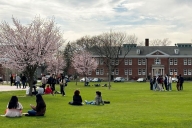You have /5 articles left.
Sign up for a free account or log in.
Recent research has suggested various ways in which girls outperform boys in high school, making them more likely to go to college: stronger desire to get good grades, better social skills, greater validation from academic performance. But a new study suggests gender sorting -- a boy’s or girl’s decision to attend one school or another – could have its own effect on the college enrollment gap.
In a study of public school systems in Florida, researchers found that what high school a student attends is “strongly associated” with college enrollment; girls are attending high schools that have higher rates of college-going than one would expect based on the students’ test scores – and boys, vice versa.
Over all, the high school that boys and girls attended accounts for 10.9 percent of the gender gap in college enrollment – in other words, 11 percent of the approximately 7-percentage-point nationwide gender gap in colleges is attributable to the high school attended -- but the figure is significantly higher for black (15.8 percent) and Hispanic students (12.2 percent) than it is for white students (5.2 percent).
While the paper does not make a causal link – it’s not clear whether the high schools themselves are causing the gaps – if it is the high schools having this effect on the students, one would conclude that equal gender distribution across high schools would close the college gender gap by 11 percent.
“Either girls are choosing to attend high schools that are going to advantage them by making them more likely to go to college, or girls are simply attracted to high schools whose students have higher college-going rates -- even if the school does not cause this outcome -- while boys are attracted to other features of high schools,” such as facilities or the characteristics of the school's students, said Mark C. Long, co-author of the paper published in Educational Researcher and associate professor of public affairs at the University of Washington.
The sample includes nearly 537,000 students who enrolled in a Florida public high school between 2002-6 and graduated within four years. While not every student has the ability to choose which high school to attend -- say, private, traditional public, or charter -- there is often some element of choice involved, either by the student selecting from a group of residential schools or a parent opting to live in a certain neighborhood.
Over all, students sort into schools based on gender at a level that’s “well beyond” what would be expected if they enrolled randomly, the paper says.
“Boys, and particularly boys of color, appear to attend high schools that disadvantage them when it comes to college enrollment,” said Dylan Conger, a co-author of the paper and associate professor of public policy and public administration at George Washington University. “The high school that they’re attending seems to be playing a nontrivial role in the gender gap that occurs later on in college enrollment.”
While girls are apparently opting for high schools with stronger college-going climates (measured by factors like instructor ability, student ambition, and knowledge and organization of guidance counselors), research has also suggested that girls are often motivated by individual characteristics -- a stronger understanding that they’ll need a college degree, for instance, and intrinsic validation from performing well academically. (The study controls for test scores, special needs and eligibility for price-reduced lunches, among other things, but you can’t measure ambition.)
“The implications of this paper, in our view, is that we need to pay attention a bit to gender sorting across schools,” Conger said, "as it may play a role in the growing female advantage in college enrollment."
Gender sorting has other potential implications as well, she added: "Monitoring these trends may be particularly important for understanding the causes of the relatively low rates of college-going among boys from traditionally underrepresented minority groups."
Since school choices are largely residential, one would think the gender breakdown would be fairly similar, the authors note. But in accounting for factors such as student achievement, teacher quality, school safety and extracurricular opportunities, many parents reported considering other options (like homeschooling) or moving to another neighborhood for school.
And previous research, the authors note, has shown differences in how parents evaluate schools based on the gender of their child: parents of girls tend to prefer same-sex schools and pay more attention to student performance, while parents of boys consider other resources such as facilities. Thus, white females are more likely than their white male peers to enroll in academically focused schools.
The sorting increases as students progress through the public school system. And however unbalanced the gender ratio is when students enter high school, it’s likely worse by their senior year because dropouts tend to skew male.
The researchers found that sorting is more prevalent in areas where students prefer private, magnet, charter and other irregular public schools.
“Thus, increasing opportunities for choice may facilitate higher amounts of gender sorting (just as they might increase sorting by race and class) in future years,” the paper says. “If continued monitoring suggests an increase in gender sorting, and further research suggests harmful consequences to such sorting, then school systems may want to consider gender balance in their school assignment policies.”








